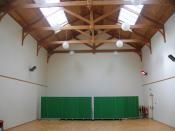When selecting a Tennis Racquet there are many factors to take into account like, length, mass, weight, elasticity and feel. The aim of this report is to study the biomechanical principles associated with all these factors like; mass, radius, moment of inertia, ease of rotation, speed of rotation, forces, design, construction, elasticity, feel and balance.
The first thing to know about a tennis racquet is that it is an extension of the arm which is a third class lever, that is axis - force - resistance. In this case the shoulder is the axis, the biceps and the flexor digitorum are the force and the ball hitting the racquet is the resistance.
When is comes to the mass and weight of the racquet you want a racquet with the biggest mass that you can control and a fairly low weight. The bigger the mass means the more area there is to hit with.
The more area there is to hit with means you get a bigger 'sweet spot' which is the ideal place for the racquet to make contact with the ball. The lighter the weight the easier it is to swing and you will have more control over the racquet. This is important when you need to respond quickly to a shot, eg. volleying a forehand drive. If you have a light racquet but not so good reflexes you will still be more efficient than the fastest reflexes with a heavy racquet.
The resistance arm is the distance from the axis to resistance, the radius. It is important to get a racquet that makes this distance as long as possible without losing any control over the racquet. The importance of having a long resistance arm is so that the speed of rotation is as fast as possible. When...



Biomechanics of tennis racquet
very good analysis. i like tha reference made to the property of moment of inertia and elasticity.a very thorough analysis indeed
4 out of 5 people found this comment useful.